AK-12 and AK-15 rifles were adopted by the Russian military at the beginning of the current year. These rifles inherited the best features of the AKM/AK-74 and added a number of small design changes that bring the good old AK to the 21st century. Although most of these changes are generally known to us, there is still quite a bit of mystery concerning how exactly some of the parts are redesigned and constructed.
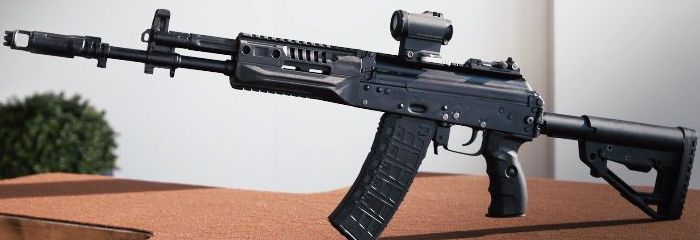
Within the past couple of weeks, Kalashnikov Media has released several videos with a more detailed explanation of new solutions incorporated into the design of these new versions of the legendary rifle. Particularly, in one of their latest videos, Sergey Radkevich, an expert with the Kalashnikov Concern, explains all the design changes and their purposes as well as demonstrates the disassembly and reassembly processes of these rifles.
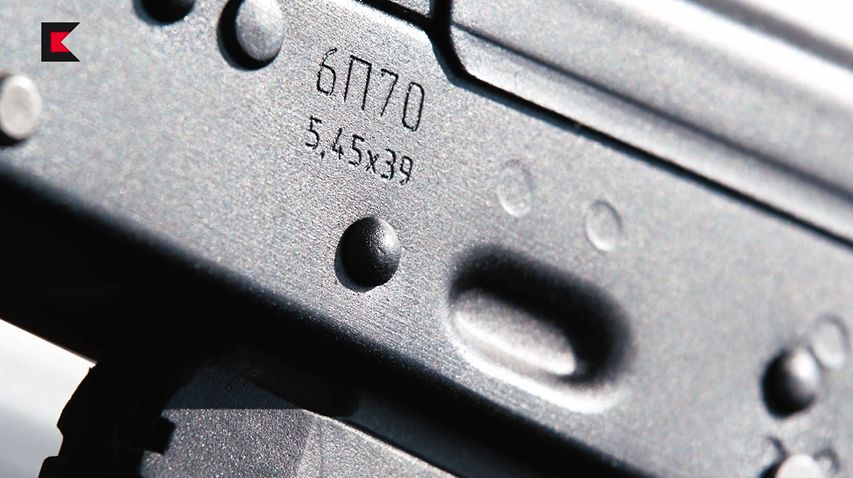
6P70 (6П70) is the GRAU index of the AK-12 rifle. The GRAU index of AK-15 is 6P71 (6П71). GRAU is the Main Missile and Artillery Directorate of the Ministry of Defense of the Russian Federation which assigns indices to the arms and equipment adopted by the Russian military.
Before we start discussing these rifles, let me remind you that the only difference between the AK-12 and AK-15 is the caliber. AK-12 is chambered in 5.45x39mm whereas the AK-15 is chambered in 7.62x39mm. So, although in the mentioned Kalashnikov Media video the new features of the rifles are shown on the AK-12, they are identical for the AK-15, too. Now let’s see what new features these rifles have.
Top Cover
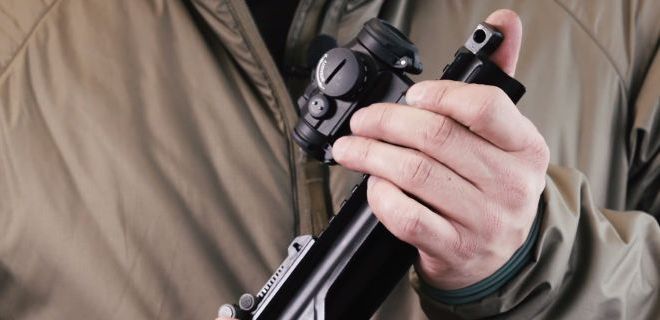
Note the front lug with a pinhole
The use of the top cover as a scope mounting platform has always been a problem in AK rifles. Many companies tried to make drop-in solutions but their effectiveness is usually questionable. What Kalashnikov Concern did is completely changed the way the top cover is mounted. It is now rigidly fixed on its front and rear points thus providing a solid scope mounting platform. The Picatinny rail on the top cover is also in line with the gas tube cover rail.
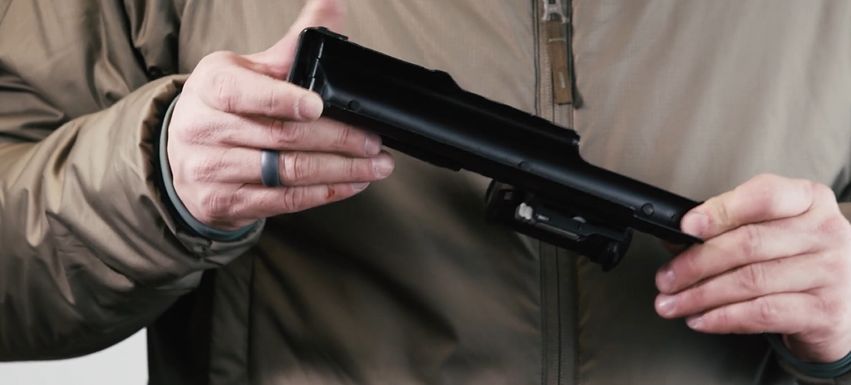
The rear retaining pin is built into the top cover
The front of the top cover has a rather large lug with a hole drilled into it. It is fixed in place by a captive pin located in the place of the gas tube locking lever of early model AK rifles. The rear portion of the top cover has a built-in spring-loaded pin which is the second attachment point. In order to disassemble the top cover, you need to rotate and pull out the front pin, then depress the rear spring-loaded pin and remove the top cover.
These new rifles have no side scope rails which basically means that Russia has officially retired the side scope rail in favor of the Picatinny rail.
Stock, Pistol Grip, and Cleaning Tools
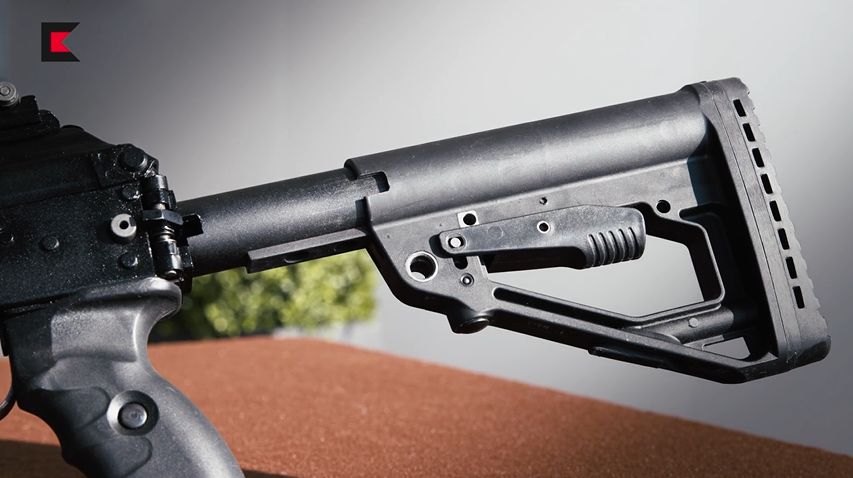
AK-12 and AK-15 stocks are folding and collapsible. There is also an ambidextrous QD sling swivel socket on the stock.
The new telescoping stocks of AK12 and AK 15 rifles have four positions which are marked on the top of the tube. The stocks also fold to the left side of the rifles. According to fellow TFB writer Vladimir Onokoy, the new AK-12/AK-15 stock tube has a different diameter than the AR-15 receiver extension which means it won’t take AR-15 stocks. I think it would be better if the stock was AR-15 compatible which would allow using one of the million different stocks made for the AR-15.

The new stock has an internal compartment that houses the 3-piece cleaning rod. Unlike most of the other AK rifles, the AK-12 and AK-15 don’t have a cleaning rod under the barrel. In order to get access to the stock compartment, you need to pull the plunger at the toe of the stock and slide the buttpad down. I think they made a good decision by not replacing the cleaning rod with a bore snake because when you need to knock something out of the barrel (elements obstructing the bore, stuck cases, squib bullets, etc.) it is kind of challenging to do it with a bore snake.
The cleaning rod sections are not loosely placed inside the stock but they are screwed into a separate housing which will eliminate the rattling of cleaning rod segments. The disadvantage of the new cleaning rod design should be the time it will take to assemble the cleaning rod compared to simply knocking/pulling it out in older AK models. Other cleaning and maintenance tools are located in the compartment inside the new ergonomic pistol grip.
Handguards
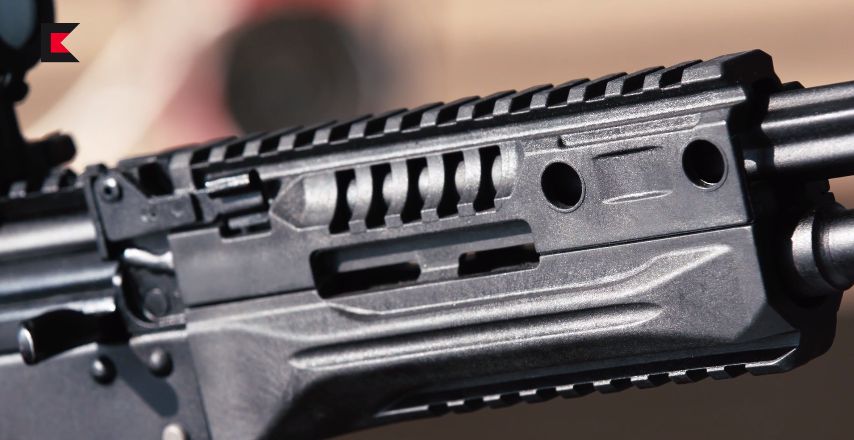
Top and bottom Picatinny rails are molded into the upper and lower handguards. The two holes at the front portion of the upper handguard/gas tube cover are designed to attach additional Picatinny rail sections.
It is arguable if we can call gas piston operated firearm barrels free-floated. In this case, when saying that the AK-12 and AK-15 barrels are free floated I mean that the handguards do not touch the barrel. The lower handguard of these rifles is attached to the receiver via a cross pin at the front bottom portion of the receiver. On its front end, the lower handguard is attached to the upper handguard (gas tube cover) via a T-slot style connection shown in the image embedded below.
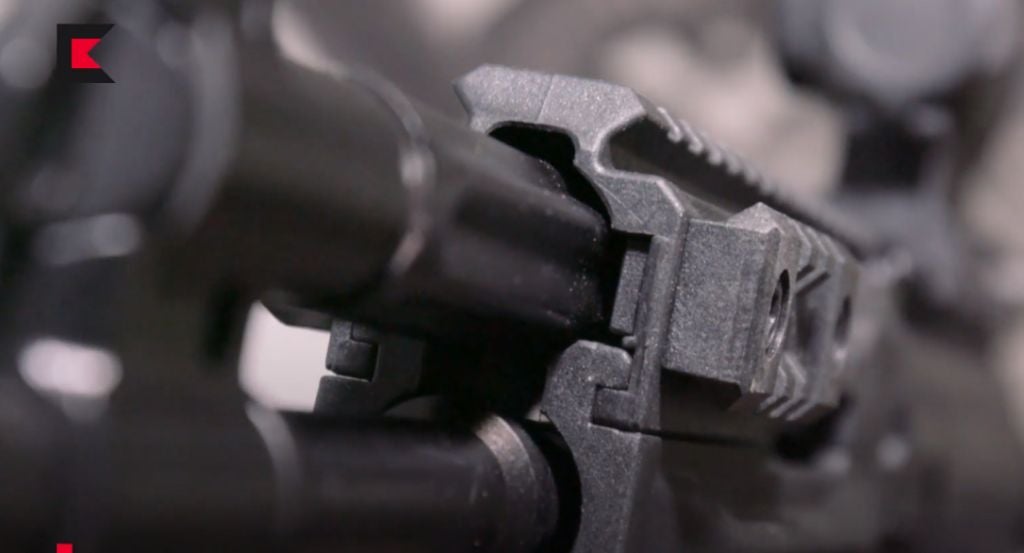
In order to disassemble the handguards, you need to use a punch to remove the tension from the lower handguard pin by pushing away the retainer spring located inside the handguard. Simultaneously, you’ll need to push the non-captive cross pin out with a cleaning rod section or another tool. As Sergey Radkevich mentions in the video, the lower handguard is very tight which I think is good for ensuring a rigid accessory mounting platform, preventing rattling and eliminating the possibility of the handguard coming loose and contacting the barrel.
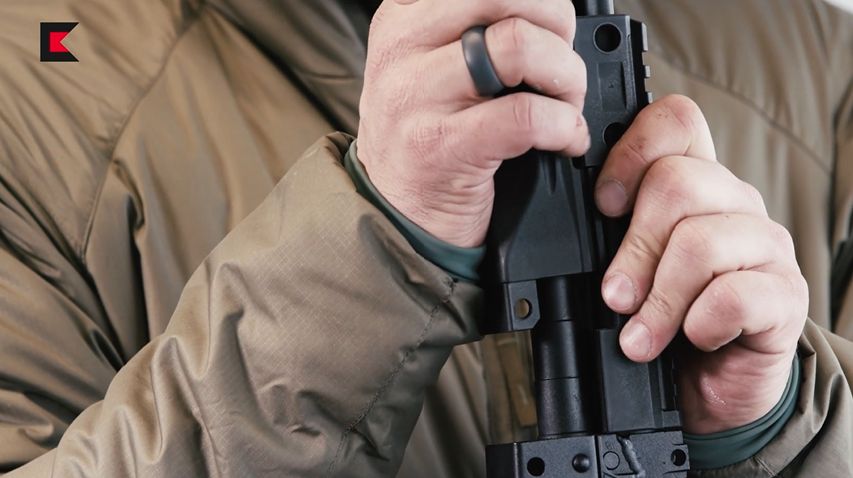
The tight fit and two-handed disassembly of the handguard may seem to be a disadvantage over previous AK models, however, there is probably no such situation where you’ll need to disassemble the lower handguard as fast as possible.
Once the lower handguard is slid forward, the upper one can be removed too. The gas tube is non-disassemblable which means the slower handguard disassembly process of these new AKs is not an obstruction on the way of getting access to the gas tube and gas block.
Iron Sights and Sling Attachment
As you can see, the AK-12 and AK-15 rifles have a front sight block and gas block combination part. Earlier this solution was seen only in shorter barreled rifles (AK-102/104/105, AK-202/204/205) produced by the Kalashnikov Concern.
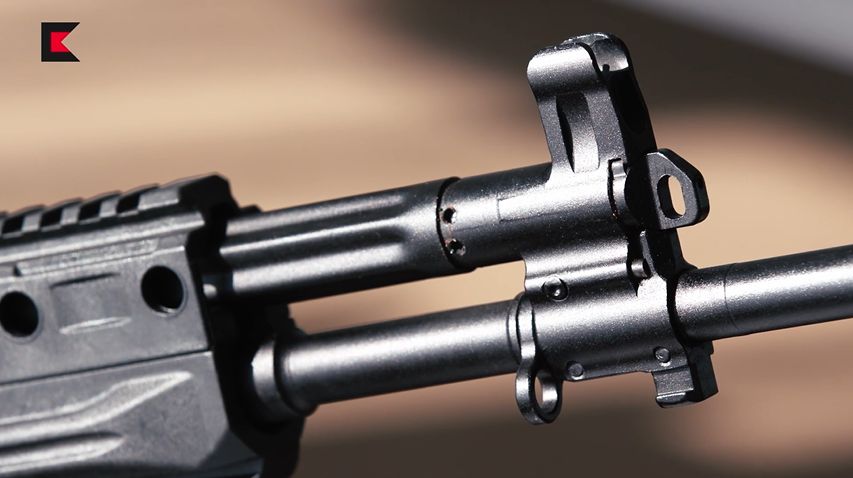
In the above-embedded image, you can see that the rotating front sling swivel is mounted on the barrel. It is basically captured between a shoulder on the barrel and the gas block. To me, it doesn’t look to be the best solution to have the sling attached to the barrel especially if you are trying to free float the barrel. I think mounting the front sling swivel on the handguard would probably be a better solution.
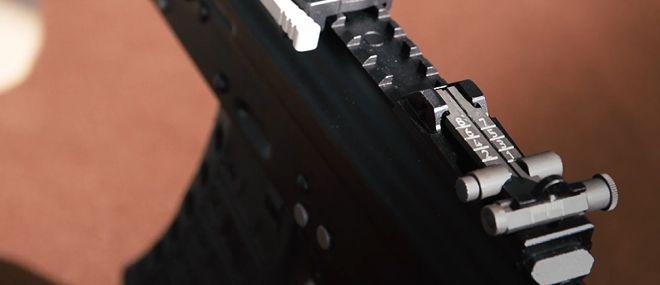
Interestingly, despite the front sight is moved rearward, the sight radius is not decreased thanks to the relocation of the rear sight which is now placed at the rearmost portion of the top cover (similar to Galil rifles). The rear sight is an aperture as opposed to the traditional AK open sights. It is also windage adjustable with a mechanism similar to that of the RPK rear sight.
Muzzle Device
The muzzle portion of the AK-12 and AK-15 rifles is equipped with a separate pinned part (in place of the front sight block of older AK rifles) which houses the muzzle device retaining spring-loaded plunger mechanism and the bayonet lug.
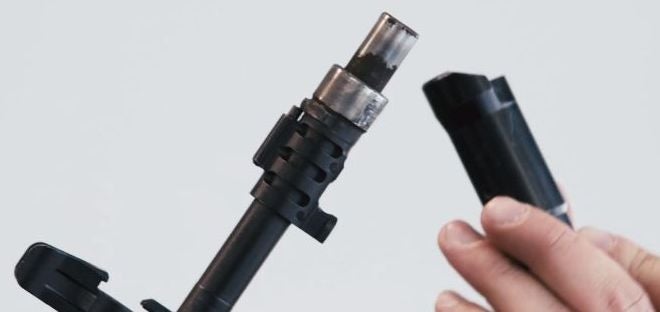
The muzzles of these rifles are not threaded. Instead of threads, they feature a quick attachment mechanism for mounting and removing the muzzle brakes/compensators and suppressors. The muzzle devices are attached by sliding them over the muzzle, rotating to catch the QD lug and fixing in place via the spring-loaded plunger.
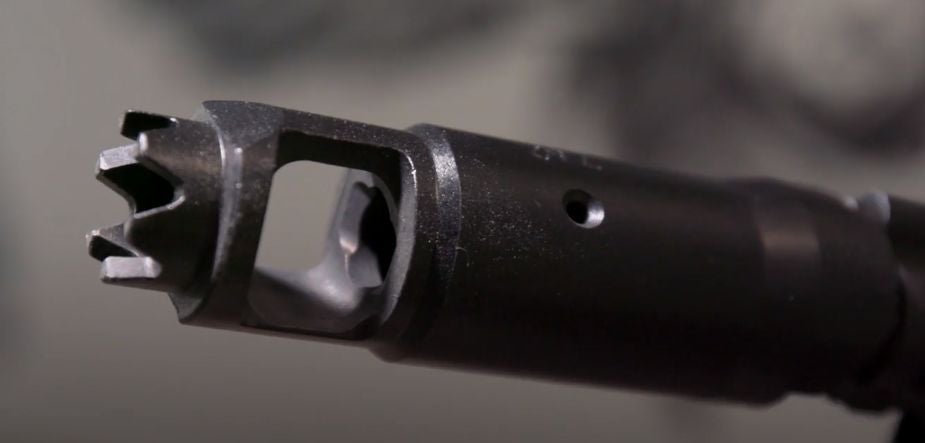
The overall design of the new standard muzzle device is similar to that of the AK-74 with the addition of front crown shape which is probably done to reduce the signature. The new muzzle brakes are marked with the caliber they are made for. The shorter versions of these rifles (AK-12K and AK-15K) have been earlier seen with birdcage type flash hiders.
Firing Modes and Safety Selector Lever
The safety selector lever has an extension for making it possible to manipulate the lever with the index finger. This style of a safety selector lever is known in the US as Krebs style safety.
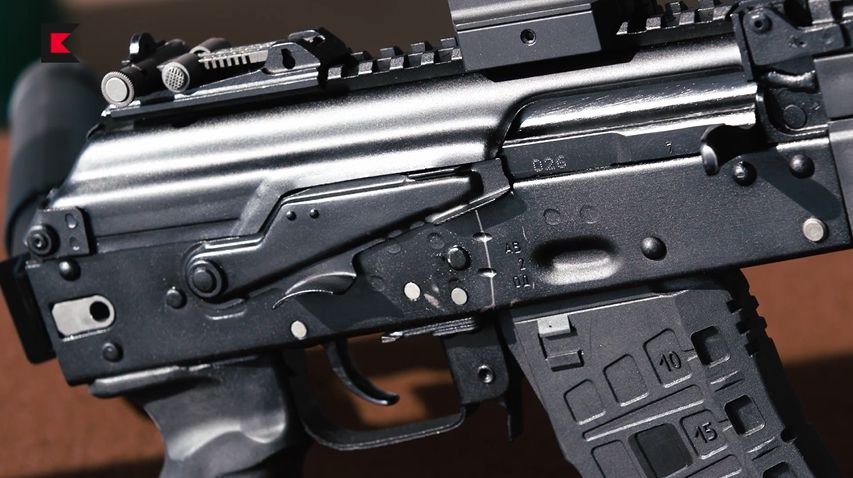
The AK-12 and AK-15 rifles have four safety selector positions: safe, full auto, two-round burst, and single shot. The two-round burst mode was one of the requirements of the Russian military. The selector position for this mode is located between the single shot and full-auto modes. The two-round burst should increase the hit probability (especially when shooting at moving targets) without requiring the shooter to manually control the burst length as in the case of firing short bursts in full-auto mode. The downside is the more complicated trigger mechanism.
Gas System
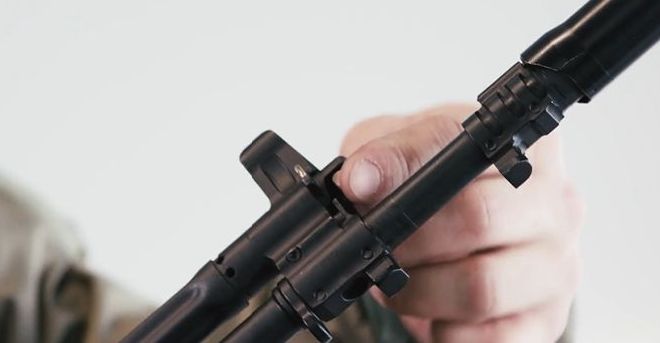
Apparently, the long stroke gas piston and BCG were basically borrowed from the previous models. However, the gas tube and gas block designs are changed. The gas tube is permanently attached to the weapon. The gas block has a separate front plug retained in place via a spring loaded plunger. In order to clean the gas tube and the gas block, you need to remove that front plug. A similar gas system layout was seen before in other Kalashnikov Concern AK-based firearms such as the Saiga 12 shotguns.

I think, if they decided to deploy this kind of gas plug design, then it could be relatively easy to make the gas block adjustable by rotating the plug and retaining it at different positions via the same spring-loaded plunger. At least having an additional suppressed setting would be really handy. I think the new gas system can be easily retrofitted with a drop-in adjustable gas block plug.
Magazines
As we mentioned in other TFB articles, the AK-12 rifles also have new magazines although they are reverse compatible with the standard AK-74 magazines.

The new magazines feature an angled surface at the bottom rear portion to provide a more rigid and stable contact with the ground when the gun is rested on the magazine. These new magazines also feature side windows showing the remaining/loaded amount of ammunition (from 10 to 30 rounds, in 5-round increments). When the magazine is fully loaded, a pin protrudes on the baseplate allowing for visual and tactile identification of the loaded magazine in the pouch.
I hope you enjoyed reading this article and learned something new about the latest products of Kalashnikov Concern and the newest Russian military rifles. Although the Kalashnikov Media videos which this article is based on, are in Russian, I’d still recommend watching them. Below you can find the links to the videos:
https://kalashnikov.media/video/weapons/kak-ustroeny-ak-12-i-ak-15
https://kalashnikov.media/video/weapons/sborka-razborka-avtomata-ak-12
Sources:
“Как устроены АК-12 и АК-15”. (2018, November 8). Kalashnikov Media. Retrieved from: https://kalashnikov.media/video/weapons/kak-ustroeny-ak-12-i-ak-15
“Сборка-разборка автомата АК-12”. (2018, November 14). Kalashnikov Media. Retrieved from: https://kalashnikov.media/video/weapons/sborka-razborka-avtomata-ak-12
Images courtesy of www.Kalashnikov.media
 Your Privacy Choices
Your Privacy Choices
